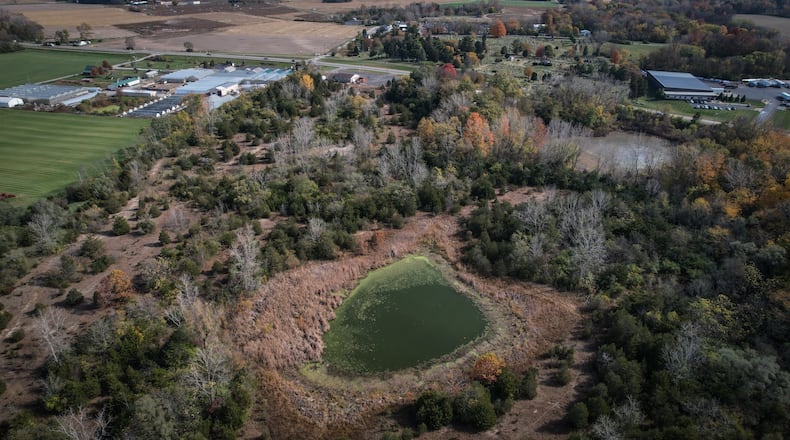History of the site
The site, on the west side of Ohio 235 across from New Carlisle Cemetery, served as a general solid waste landfill from the mid-1950s to the early 1970s, receiving industrial, commercial and residential waste, according to the EPA website. It closed in 1977 and has remained unused for over 45 years.
In 2005, the EPA did emergency cleanup after sampling detected volatile organic compounds, including known carcinogen vinyl chloride, in groundwater south of the landfill. In 2009, the site was placed on the National Priorities List over concerns vinyl chloride could migrate toward residential wells within a half mile. More studies were done last decade.
Officials are currently starting the remedial design phase of the area known as OU1, the former landfill itself, along with residential and commercial properties adjacent to the landfill to the east, EPA remedial project manager Anna Nguyrn said this week. She said they must determine the specific engineering drawings and construction designs to complete the actual remedy.
“We are looking at collecting additional data from OU1 to help further support the designs on what the remedy would look like,” Nguyrn said.
Conditions, EPA plans, timeline
After the design is complete, the EPA will look at engineering and remedial action/construction.
“The remedial design phase depends on how long it would take to get supporting information … we are estimating around three years,” Nguyrn said, explaining they haven’t started collecting supporting information for the remedial design yet, but the goal is in 2025.
Credit: Bill Lackey
Credit: Bill Lackey
The landfill is currently topped with a vegetated clay cover ranging from 2-4 feet deep, but it was not designed with a protective liner like modern landfills. While no waste or contamination has been found at the surface of the landfill parcel, according to EPA, additions to the cover are necessary to meet current federal and state requirements.
The EPA said groundwater in the area flows in a southerly direction. Since New Carlisle’s public water supply production wells are 1.7 miles northeast and upgradient of the site, they are not impacted by the landfill.
Details of cleanup plan
The EPA released a proposed cleanup plan in 2020 to address part of the landfill and groundwater at the site. In 2021, the Record of Decision that described the cleanup plan was finalized. The remedy for OU1 included:
- Enhancing the existing cap, or cover, over the landfill and installing vents to allow for landfill gas to be released passively.
- Treating on-site groundwater by injecting microorganisms in combination with vegetable oil or iron powder, known as zero-valent iron, into the groundwater to break down the contamination.
- Installing systems in nearby buildings to actively prevent the potential for contaminated vapors migrating into the buildings.
- Placing restrictions on land-use to protect the landfill cap, limit exposure to waste, ensure people do not drink contaminated water, and ensure the protection of human health on future developments on properties with potential for vapor intrusion.
Community group watching
Larry Ricketts, of the People for Safe Water group, has experience with EPA cleanup via involvement in the Tremont Barrel Fill site for the last eight years.
“There’s obviously some risk involved to somebody or (the New Carlisle Landfill) would not have been designated as a superfund site,” Ricketts said.
Ricketts said all kinds of things were dumped at the site, with no record of what materials came to the landfill.
“It’s almost impossible to dig up an entire landfill and get rid of whatever’s in there,” he said.
Credit: Bill Lackey
Credit: Bill Lackey
As for the remedial action, Ricketts said the only thing the EPA can likely do is put more dirt on top, because it never had any kind of liner on top or bottom. They can put a new, stronger cap on it, have a ventilation system to vent out the natural gas that’s produced from landfills, and monitor it and do some new well-testing.
“I imagine the main concern with the water out there is that Mud Creek runs very close to that area (south of the landfill) and Mud Creek eventually runs into Mad River, so I’m assuming that should be of concern to them,” Ricketts said. “But I don’t think they’ve been able to build because of the designation as a superfund alternative site ... it’s not the kind of thing that you can just go in and clean up by hauling everything away. ... Until they get this remediated nobody’s going to want to buy a new house that’s next to a superfund site.”
Ricketts added that the new Record of Decision is what will show what the EPA will officially do to the site.
Back in the 2005 cleanup, the EPA provided alternate safe water to the Scarff’s tree nursery immediately south of the landfill, and to residences with contaminated private wells. They extended the water line from New Carlisle public water system to Scarff’s and to two homes. A new public well was installed and is utilized for irrigation.
About the Author




